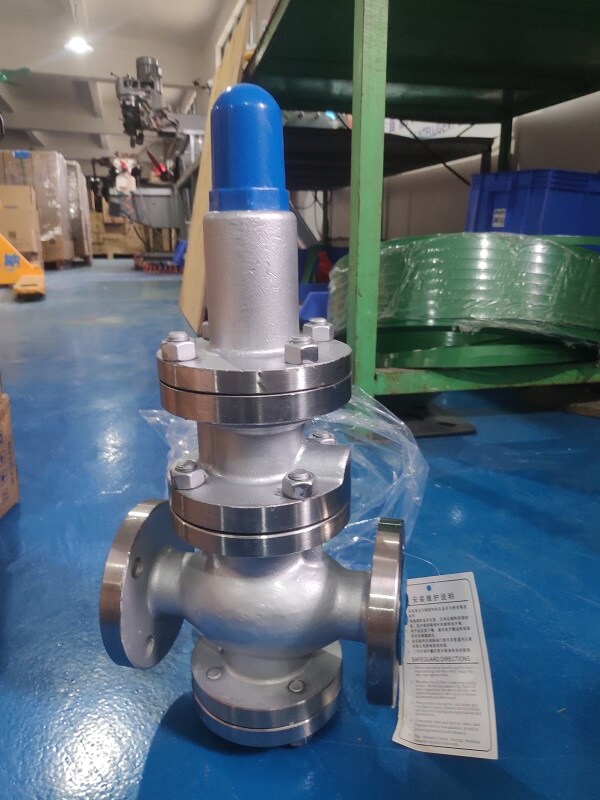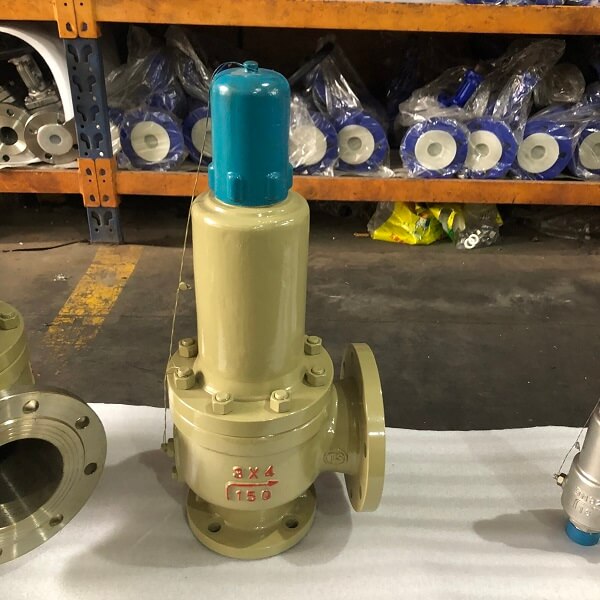Safety Valve is one of the three indispensable safety accessories on the boiler. It plays an important role in controlling the pressure limit value and protecting the boiler. When the pressure in the boiler rises above the specified value, the safety valve automatically opens to relieve pressure and discharge steam; when the pressure in the boiler drops to the specified value, the safety valve automatically closes. If the safety valve is not properly selected or adjusted, it is easy to cause the boiler overpressure and explosion accident. Therefore, it is an important content of boiler safety management to know and use the safety valve correctly.
1. Structure Management
(1) Spring-type Safety Valve: spring-type Safety Valve is mainly composed of valve seat, valve core, valve stem, spring, guide sleeve, adjusting screw, lifting handle, valve body and other components. It uses the spring to act on the pressure on the Spool to balance the steam pressure acting on the spool. When the steam pressure acting on the spool is greater than the spring acting on the pressure on the Valve Center, the spring is compressed, the Spool is lifted off the valve seat, and the steam is discharged outwards The valve core is pressed down to be closely combined with the valve seat, and the steam stops discharging outwards.
The spring-loaded safety valve controls the exhaust pressure by adjusting the spring tension. The utility model has the advantages of compact structure, lightweight, can be shaken without air leakage, and is the most commonly used safety valve on boilers at present. But because the spring’s elasticity is affected by temperature, time and other factors, so the reliability is poor, the safety valve must be tested regularly in use.
(2) Lever Safety Valve: Lever Safety Valve consists of body, disc, seat, stem and weight. It is the role of the lever and heavy hammer, the disc will be compressed in the seat, when the steam pressure acting on the disc is more than the weight acting on the pressure of the valve stem, the disc is jacked up, the steam through the relief valve discharge, the steam pressure is then reduced; When the steam pressure acting on the disc is less than the weight pressure acting on the stem, the disc is pressed back against the seat to keep the boiler running. The opening pressure of the Lever Type Safety Valve is controlled by adjusting the distance between the weight and the fulcrum. After the opening pressure of the relief valve is determined, the distance of the Fulcrum of the heavy hammer can be calculated by using the lever principle, and the position of the heavy hammer can be determined. Lever-type safety valve structure is simple, easy to adjust, action recording live, more accurate and reliable. But the heavy hammer is relatively heavy, a single safety valve exhaust capacity is limited, the installation requirements are more stringent.
2. Technical requirements for Safety Valves
Safety Valve selection should meet the use of requirements. First of all, to understand the safety valve specifications and models, in the use and identification, especially to pay attention to sealing surface materials, valve body materials and nominal pressure to meet the requirements, and sealing, adhesion and other issues. Generally used in steam safety valve. The body is made of carbon steel and the seat is made of stainless steel.
Nominal pressure relief valves require a reference temperature of 120 °C and a steel body of 200 °C. When the medium of Boiler Safety Valve exceeds 200 °C, the maximum allowable working pressure should be lower than the nominal pressure. Therefore, the saturated steam pressure of more than 1.47 MPA and superheater boiler, according to the working temperature to choose the safety valve.
Number of safety valves. Boilers with a rated evaporation capacity of 0.5 t / H shall be provided with at least two safety valves (excluding economizer safety valves) . For boilers with evaporation less than 0.5 t / H, install at least one safety valve. Safety Valve must be installed at the outlet (or inlet) of the separable economizer and the outlet of the steam superheater.
The Safety Valve shall be installed perpendicular to the ground and as far as possible at the highest position of the drum and container. Between the safety valve and the drum or between the safety valve and the header, shall not be installed to take the steam outlet pipe and valve.
Calibration of opening pressure of safety valve. The opening pressure of the safety valve shall be adjusted and calibrated according to the values specified in the table. For Boilers with only one valve, the opening pressure of the safety valve is adjusted according to the lower values in tables 1.2-2; for boilers with superheaters, the safety valve on the superheaters is adjusted according to the lower pressure; for boilers with separable Economizers, the opening pressure of the safety valve on the economizer is 1.1 times of the working pressure at the installation site. There are economizer, superheater boiler, its safety valve opening order is: First superheater safety valve, then the boiler drum, finally economizer, to follow the principle of ensuring the safety of high-temperature components.
Lever-type relief valves shall be provided with a device to prevent the weight from moving by itself and a guide frame to limit the overrunning of the lever. The spring-loaded Relief Valve shall have a lifting handle and a device to prevent the random turning of adjusting screws.
Connection of Safety Valve. If several safety valves are installed on a short pipe directly connected to the drum, the cross-sectional area of the short pipe should not be less than 1.25 times of the cross-sectional area of all safety valves. For boilers with working pressure ≤3.82 MPA, the inner diameter of the safety valve seat shall not be less than 25 mm.
Safety Valve should be installed in general exhaust pipe, exhaust pipe should be as far as possible straight outdoor, and have sufficient cross-section area, to ensure that the exhaust unobstructed. The bottom of the relief valve exhaust pipe shall be provided with a drain pipe connected to a safe place. Valves shall not be allowed on either the exhaust pipe or the drain pipe. The relief valve of the economizer shall be fitted with a drain pipe leading to a safe location. No valves are allowed on the drain pipe.
Do Regular outgassing or outgassing tests. In order to prevent the safety valve disc and seat stuck, should be regularly on the safety valve for manual or automatic venting or drainage test.
Points for attention in management and use. After the safety valve is checked, it should be locked or sealed with lead. It is strictly forbidden to add weight, move the weight and jam the disc to prevent any increase in the opening pressure of the safety valve or make the safety valve invalid.
Post time: Jul-28-2021






